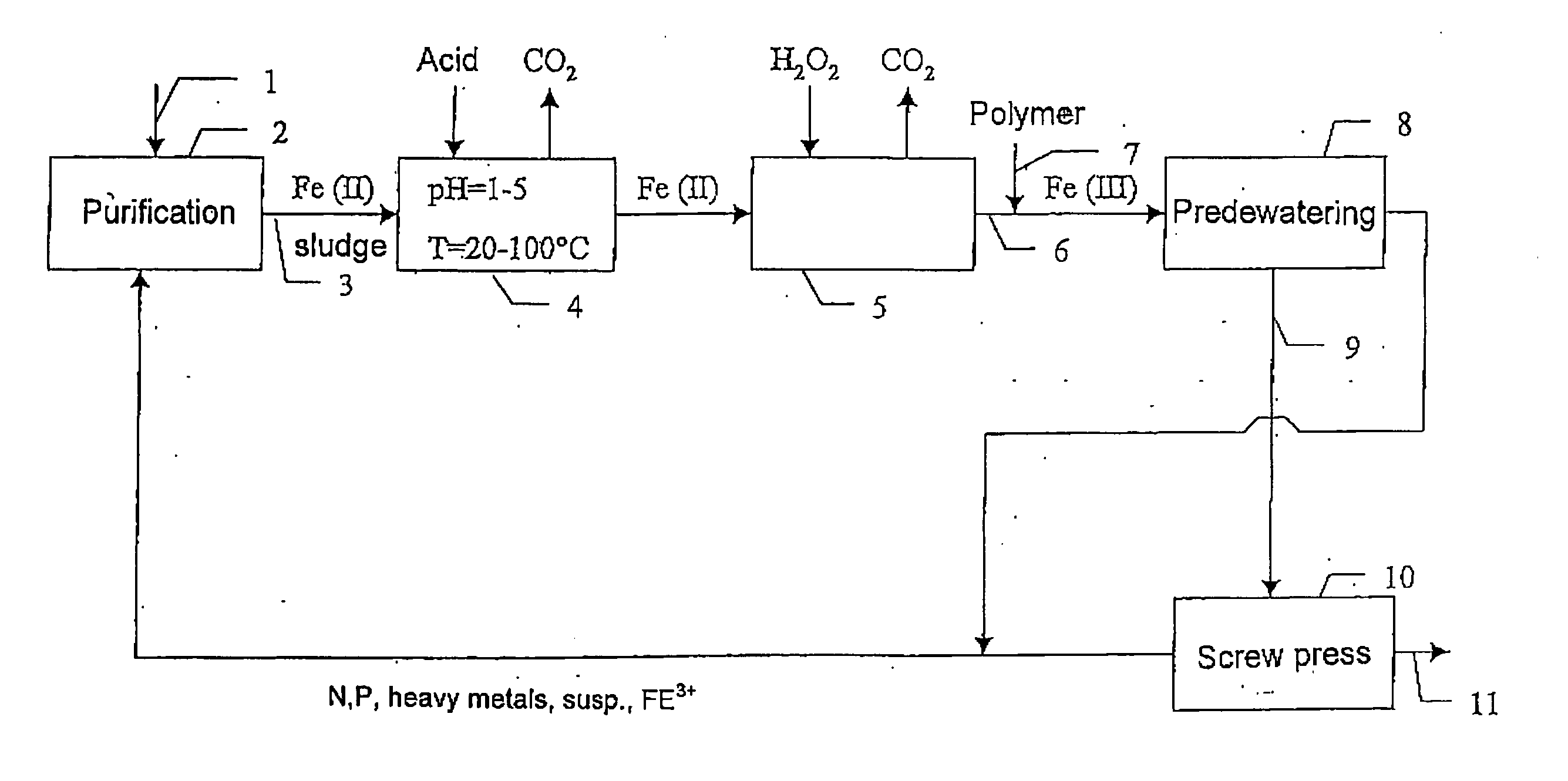Method of treating digested sludge
a technology of digested sludge and sludge, which is applied in the direction of sludge treatment by oxidation, water/sewage treatment by oxidation, and separation processes, etc. it can solve the problems of increasing sludge use, large space and cost, and the need for storing digested sludge on landfill sites, etc., to facilitate mechanical dewatering, facilitate drying, and good filtering effect of sludg
- Summary
- Abstract
- Description
- Claims
- Application Information
AI Technical Summary
Benefits of technology
Problems solved by technology
Method used
Image
Examples
example 1
Digested sludge was treated according to the invention by acid treatment, treatment with an oxidiser (hydrogen peroxide) and dewatering. The treatment took place at different temperatures. Then the contents of the following bacteria were determined: a) coliform 37° C., b) thermotolerant coliform, c) presumptive Escherichia coli, d) Clostridium perifringens, and e) salmonella.
In parallel the same determination was made on a sample of the same digested sludge that had not been treated according to the invention, but only heated to 70° C. for 30 min at pH 6.85. Moreover the bacterial content was determined in a blank of the digested sludge, i.e. a sample that had not been subjected to any treatment at all. The results are stated in Table 1. The Table states the sample marking kg 100% hydrogen peroxide / temp, ° C., for 30 min / pH. The values in the Table relate to the number of colony-forming units per ml of sludge having a solids content of 2.5% (cfu / ml)
TABLE 1Sample markingColiform...
example 2
The solids content (TS=dry solids) from two dewatering devices is compared on the one hand after treatment according to the invention by acid treatment and treatment with an oxidiser (hydrogen peroxide) and, on the other hand, without treatment according to the invention.
The sludge (digested sludge) contains at the inlet to the acid treatment and at the inlet to the dewatering devices 3% TS flocculated with polymer. The dewatering devices comprise a centrifuge, in which the sludge has a retention time of less than 1 min, and after that a screw press which is preceded by a dewatering drum. The screw press applies a pressure of 50 bar and the retention time of the sludge in the screw press is 15-30 min. In the dewatering drum, the sludge is dewatered to a TS content of 10-15% and is then fed to the screw press, the TS content being further increased. The results are stated in Table 2.
TABLE 2CentrifugeScrew pressTSUntreatedH2SO4: 360 kg / tonne TSUntreatedH2SO4: 350contentH2O2: 30 k...
example 3
The digested sludge was treated according to the invention by acid treatment, treatment with an oxidiser (hydrogen peroxide) and dewatering using a screw press. The following results were obtained at different temperatures.
TABLE 3HydrogenDry solidsTemperatureperoxideafter dewatering(° C.)(g / kg TS)pH(%)251003.63730100339701003.547
As is evident from the results, the treatment according to the invention gave a clearly increased TS content with an increased temperature.
PUM
| Property | Measurement | Unit |
|---|---|---|
| Temperature | aaaaa | aaaaa |
| Weight | aaaaa | aaaaa |
| Weight | aaaaa | aaaaa |
Abstract
Description
Claims
Application Information
 Login to View More
Login to View More - R&D
- Intellectual Property
- Life Sciences
- Materials
- Tech Scout
- Unparalleled Data Quality
- Higher Quality Content
- 60% Fewer Hallucinations
Browse by: Latest US Patents, China's latest patents, Technical Efficacy Thesaurus, Application Domain, Technology Topic, Popular Technical Reports.
© 2025 PatSnap. All rights reserved.Legal|Privacy policy|Modern Slavery Act Transparency Statement|Sitemap|About US| Contact US: help@patsnap.com


